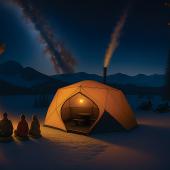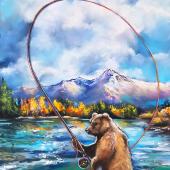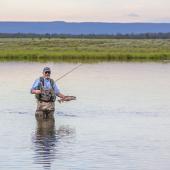Dirty Fingers and Deviant Humor
There is no mistaking the home of Livingston artist Parks Reece: a five-foot cartoon chicken perches on the mailbox amid animal bones and skulls scattered about the trees and fence posts. “Hi there!” Parks says in a mild-mannered Carolina drawl as he welcomes me in. (He later admits he considered spicing up our introduction by wearing a Mexican wrestling mask recently purchased on a trip to Baja.)
The chicken is proof that Reece’s artistic inclinations no doubt extend beyond the world of canvas and paint, but his work in those media has received national and even international acclaim. Born in the 1950s in the hills of North Carolina, Reece grew up with a nature-loving family who instilled an appreciation for nature early in life. Montana’s vast remoteness drew him here in his mid-twenties, as it felt even wilder than the East Coast backcountry of his childhood. “Montana has more deer than people,” he says. “I like that.”
Reece works extensively in printmaking, acrylic painting, and even finger painting. Because the term “finger painting” too often conjures images of Crayola tubes and paint-splattered toddlers, Reece sometimes refers to this craft as “painting with the hand.”
Western wilderness is prime material for him, though he brings a twist of whimsy and humor that typical Western-themed paintings don’t have. In a way, he’s making fun of the stereotypes that Western art is famous for.
A typical Reece painting might portray Adam and Eve touring Yellowstone, for example, or cowboys on cell phones, or the “trout dream” of flying through the sky with geese. His work brings to mind a Far Side cartoon and a Monet, united under a title like “Heaven and Mirth.”
“I’m parodying fishermen and nature painters in a mild way, and parodying the art world,” he says.
Reece spends as much time outdoors as he does behind the canvas. These days, he hunts and fishes for most of the meat in his freezer, and he spends many summer afternoons floating local rivers. He believes that the wild remains within humans. “Nature is instilled in us−we’re animals, unless we’ve had it drilled out of us by extreme city living,” he explains. “I think everyone is captivated by the mystique of the wild.”
This human wildness comes through in his art: animals with human qualities, and humans with animal qualities, illustrating both the absurdity of human civilization and a deeper profundity when we step closer to the great wild that birthed our species long ago. Reece’s art reminds us that we can exist in a civilized society and still answer the voice of the wild calling from within and without.
“Art is a way that you try to uncover some of what lies beyond the veil,” he says. “Though the subject matter may be whimsical or folk-oriented, not holding much gravity, I’m trying to work on a deeper level with the application of the paint and visual language. I’m inspired by physicists who can imagine something and prove it in math. I like to think I can imagine something and prove it in paint.”
Reece’s lithographs in particular have earned him much renown in the art world. Lithography is a type of multilayered printmaking—like a more subtle and detailed form of impressionism. “Lithography is a chance to get more colors and a radically different look than you can with painting,” he notes.
Reece creates a radical effect by layering several dozen prints on top of each other. First he draws an image on mylar, a plastic sheet, and then transfers the drawing to an aluminum plate. Each plate prints only one hand-mixed color ink. The ink sticks to the image on the plate, and the rest of the plate repels it. Using a printing press, Reece then transfers the image onto a piece of paper. He repeats this process up to 27 times to create a final product.
Why a medium as labor-intensive as lithography? “It’s hard. It’s all the adventure you can have without risking your life,” he says. The process is always riddled with unforeseen challenges and results in a kind of “controlled accident,” he adds. “I don’t know exactly how it’s going to end when I start a lithograph.”
Back at my tour of the Reece property, I point to what appears to be a mummified cow udder hanging over the doorway of his living room. “Oh, that was Christmas gift to my ex-mother-in-law. I picked it up in Argentina, where some women use dried udders as a purses,” he explains. “She dropped it on opening the wrappings and never picked it up again.”













